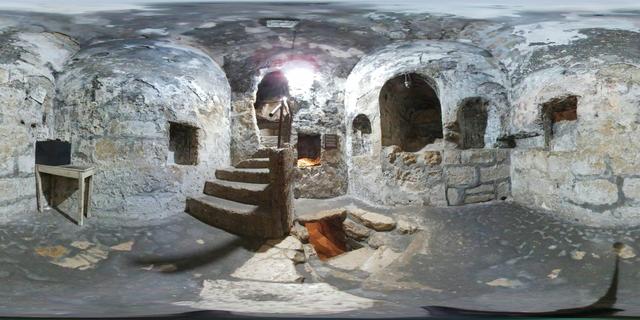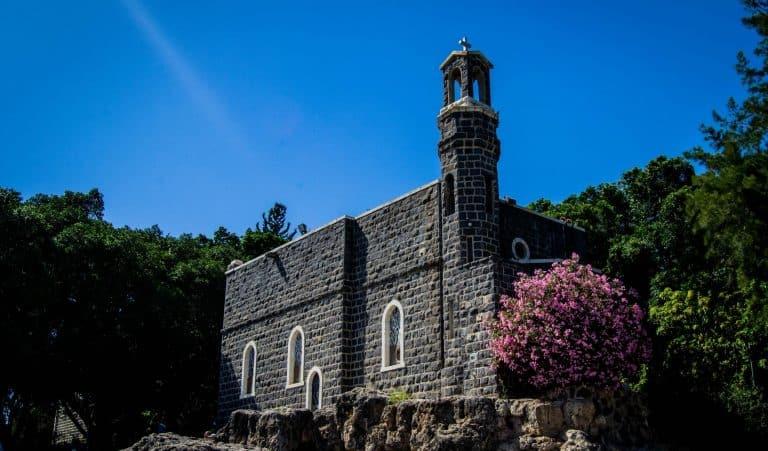A small dark stone church stands on the shores of the Lake Tiberias in the northern region of Galilee. Three small windows in neo-Gothic style appear on its gabled façade, completed by a sober, slightly splayed portal. This is the chapel of the Primacy of Peter, where, according to the twenty-first chapter of the Gospel of John, the disciple received forgiveness from the Lord for his betrayal and the role of leader of the apostles.
The story of the Primacy of Peter
John tells how Peter, defeated and humiliated after denying the Master at his trial, went fishing on Lake Tiberias, followed by other disciples. The night passed without result and at dawn, an hour too late for fishing, the nets were still empty. Then Jesus, " was there by the edge of the sea, though the disciples were not conscious that it was Jesus. Jesus said to them, 'Children, have you taken any fish?' They answered him, 'No.' ' Then he said to them, 'Let down the net on the right side of the boat and you will get some”. So they put it in the water and now they were not able to get it up again because of the great number of fish. So the disciple who was dear to Jesus said to Peter, It is the Lord!”
Peter, says John, "went into the sea" and swam to Jesus in haste. Here the Master, eating with the disciples, three times asks Peter if he loved him more than the other disciples. . And three times, a number equal to the number of denials, Peter answers in the affirmative. . Jesus then entrusts Peter with the authority: "Then give my sheep food".
The Primacy of Peter in Tabgha
It is this episode that is remembered today. And it is precisely to remember it that the Chapel of the Primacy of Peter was built. It is a building of modest proportions,jutting out into Lake Tiberias with its small, squat bell tower. Franciscan property since the end of the 19th century, the land on which the chapel stands could only be built in 1934.
The location of the sanctuary is Tabgha, a name probably derived from heptapegon, meaning 'place of the seven springs'. Indeed, the spring waters are very abundant here and contribute to making this part of the shore of Lake Tiberias a real garden, which does not fail to attract pilgrims and visitors.
The story of Tabgha
It is unclear what stood on the site of Tabgha in ancient times. The only account we possess today is the one written by the pilgrim Egeria (or Eteria), who travelled to the Holy Land in the 4th century. The woman affirms that near Capernaum one could still see "the stone steps on which the Lord stood". In all likelihood, Egeria is referring here to the stone slabs that are still visible outside the chapel of the Primacy of Peter. However, the pilgrim does not pass on any news of a church in this place. Indeed, Egeria states that column foundations were visible near the steps, but says no more. From late medieval legends we know that these six column foundations, built as double columns, were considered the 'thrones of the twelve apostles'.
We know that Tabgha was not a particularly suitable place for settlement. Although water was abundant, in fact, the soil was too rocky for cultivation. Indeed, recent excavations have shown that the site on which the chapel of the Primacy of Peter stands today was long used as a stone quarry .
The Primacy of Peter and its surroundings
And indeed, Egeria speaks of only one building in Tabgha, on the shores of the lake. It is the structure of the Mensa Christi, which must have stood not far from where the chapel of the Primacy of Peter can be seen today. Egeria speaks of it as a building dedicated to worship, but it was not intended as a church proper. It must have been something like a sacred space for communal meals. In all likelihood, it was a place to commemorate the multiplication of the loaves, a Gospel episode also located on the shores of Lake Tiberias, where Jesus had a home with his disciples. Luke speaks of it in chapter nine of his Gospel.
Not far from the Chapel of the Primacy of Peter stands one of the oldest Christian memorials in the Holy Land. It is the Convent of the Beatitudes, now unfortunately in complete ruins and still awaiting serious restoration work to enable it to be properly appreciated.
























